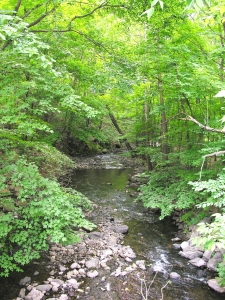“The Ravine”
Windows Through Time
Columbia/Greene Media
July 29, 2009
Robert and Johanna Titus
When one of us (Robert) was a boy of about ten, one of his absolutely favorite places to go with his friends was a place simply called “the ravine.” It was a pretty decent canyon cutting through a sequence of Triassic age red sandstones. Boys would hike up and down it, scramble beneath overhanging ledges of rock, and just have a good time. As a grownup geologist his life hasn’t changed much. The one exception being that now he now explores ravines with his writing partner and wife.
To the two of us the word ravine still conjures up images of damp recesses and moss covered rocks, with fern forests, whitewater brooks and plenty of rapids. Ravines are still nice places to go, and hike, and explore.
But, as you can probably guess, there is a lot more. We’d like to take you to a ravine in the Hudson Valley and take a look at it and learn something of its marvelous history. That would be the ravine found along something called Doove Kill. We’d like you to visit it with us, take a good look at it, and then, most importantly, think about what a ravine really is.
To get there we would like you to find your way to the village of Blue Store, along Rte. 9 in Columbia County. From there, take County Rte. 8 east and uphill. Travel just about three miles and watch for Black Bridge Road. Turn left there and you will very quickly encounter a bridge. The bridge passes across D oove Kill, and you can park near it, get out and take a look. Here you can get your first glimpse of the ravine and actually think about ravines in general.
oove Kill, and you can park near it, get out and take a look. Here you can get your first glimpse of the ravine and actually think about ravines in general.
The features that most identify a ravine are the walls of rock that make up their steep slopes. You can see them here. Typically, the creek is forced to pass across ledges of bedrock and they break up its flow and produce whitewater which helps the scenery considerably. Turn around and continue east on Rte. 8 for just about a half mile more. You will soon enter the village of Snyderville and there you will find Taghkanic Road. Turn left onto Taghkanic and watch, again to your left, as you continue down that road; you will soon see more of Doove Kill.
For a short distance the road passes parallel and very close to the Kill. Here it is a very real ravine; it meets all of the criteria. It is deep, steep-sloped, and has plenty of exposed bedrock. There are two small waterfalls here, but unfortunately they are on private property, and we would like it if you did not disturb the residents. But there are places where you can pull over, park, and gaze into the gorge, without bothering anybody. It’s a nice place, except for the poison ivy!
But, we have been promising to do some thinking about what exactly a ravine might be, so we had better get going on that. We can learn more by returning to Rte. 8 and driving farther east, and finding our way into Lake Taghkanic State Park. As you can guess the park is named after the lake that is there. If you drive to the northwestern corner of Lake Taghkanic you will find the source of Doove Kill.
We have to go back into time about 14,000 years. Back then the Lake was a great deal larger than it is today; and a lot deeper. The lake was swollen with the water melting off of retreating glaciers. Flowing out of that ice age version of the lake was an enormous volume of water. In short Doove Kill had a very different personality back then. It was a raging, foaming, pounding, thundering, whitewater and ice age torrent.
Now you must rethink everything that you have just seen along Doove Kill. In your mind’s eye, we would like you take those stretches of ravine that you just saw on Black Bridge and Taghkanic Roads and fill them, almost to the top, with that powerful whitewater flow. That makes Doove Kill something that you might call a Category Six whitewater stream, or at least is was back at the end of the Ice Age.
Changes your impression of Doove Kill, doesn’t it?
You might even say that it rearranges your whole sense of reality. All of a sudden your image of the Kill has been dramatically altered. It has become a far more exciting place, one with a real ice age heritage.
And that is the whole point. We all started out with an appreciation for the scenic beauty of something that we called “the ravine.” Probably all of us have been to our own ravines and enjoyed the experience immensely. But now we have learned something very different. There is the notion that such a landscape feature has a geological heritage. And it can be a very rewarding experience to come to understand that heritage.





